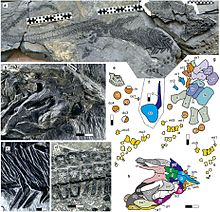Sclerocormus
| Sclerocormus | |
|---|---|

| |
| Holotype | |
| Scientific classification | |
| Domain: | Eukaryota |
| Kingdom: | Animalia |
| Phylum: | Chordata |
| Class: | Reptilia |
| Clade: | †Ichthyosauromorpha |
| Clade: | †Ichthyosauriformes |
| Clade: | †Nasorostra |
| Genus: | †Sclerocormus Jiang et al, 2016 |
| Species: | †S. parviceps
|
| Binomial name | |
| †Sclerocormus parviceps Jiang et al, 2016
| |
Sclerocormus is an
Description

Sclerocormus is much larger than its closest relative Cartorhynchus, with a total body length of 1.6 m (5.2 ft) and body mass of more than 15 kg (33 lb).[1][2] Its proportions were unusual amongst basal ichthyosauriformes, with a short, heavily built trunk, a very long tail over 92 cm long (58% of the total body length), and a small skull with a short, narrow snout and toothless jaws.[1]
Like Cartorhynchus, the skull of Sclerocormus is wide, with a short,
The trunk is short and heavily built, with broad and flattened ribs. The ribcage is deepest at the shoulders and gradually becomes shallower, forming a straight, constant slope, similar to Cartorhynchus but in contrast to the more rounded underside seen in other
Discovery and naming

The full binomial name, Sclerocormus parviceps, comes from the Greek words for 'stiff trunk' (σκληρός, skleros and κορμός, kormos) and the Latin words for 'small skull' (parvus and caput).[1]
Classification
In the phylogenetic analysis performed by Jiang et al. 2016, Sclerocormus was found to be a basal ichthyosaurform and as a
As the holotype of Cartorhynchus was potentially not fully mature,[3] it was possible Sclerocormus simply represented a large or mature Cartorhynchus. However, it was established this was not the case, as there were significant anatomical differences between the two genera, including different presacral vertebral counts and the form of the gastralia, that could distinguish between the two taxa.
This cladogram represents a simplified form of the phylogeny from Jiang et al. 2016:[1]
| Ichthyosauromorpha |
| ||||||||||||||||||
Palaeobiology
Due to its heavy build and body shape, Sclerocormus likely inhabited shallow waters, as with Cartorhynchus, and was probably a slow swimmer. The narrow, toothless snout indicates Sclerocormus was likely a suction feeder, using its snout to generate syringe-like pressure concentration to suck in soft-bodied prey.[1] Due to the small size of its jaws and head relative to its body, Sclerocormus would have been limited to feeding on prey much smaller than itself.
